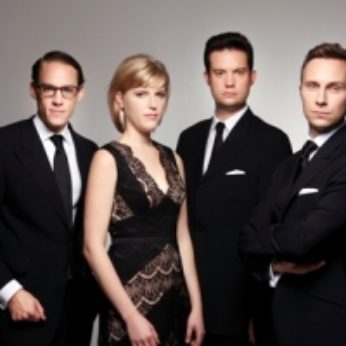Composer: Leoš Janáček (b. 1854 - d. 1928)
Performance date: 27/06/2014
Venue: Bantry Library
Composition Year: 1923
Duration: 00:18:57
Recording Engineer: Richard McCullough, RTE
Instrumentation: 2vn, va, vc
Instrumentation Category:String Quartet
Artists:
Doric String Quartet (Alex Redington, Jonathan Stone [violins], Hélène Clément [viola], John Myerscough [cello]) -
[quartet]

His
music is a breathtakingly close confrontation between tenderness and brutality,
madness and peacefulness; it condenses the whole of life, with its hell and its
paradise.
In the last ten years of his life Janácek
wrote four magnificent operas – Katia
Kabanova, The Cunning Little Vixen,
The Makropulos Case and From the
House of the Dead – as well as several other major works, including his two
quartets. This sustained surge of creativity was partly driven by international
recognition following the long-delayed production of Jenufa in
pride following the independence of the
by his infatuation with the 25-year-old Kamila Stösslová, whom he met when he
was 63. He also attended several International Society of Contemporary Music
festivals, which encouraged him to explore new paths.
Schönberg in Verklärte Nacht had shown how chamber music could be inspired by a
literary text, and it was Tostoy’s novella ‘The
Kreutzer Sonata’ that gave Janá?ek the extra-musical inspiration that he
needed to pour out his feelings for Kamila. The story spoke of the terrible
power of music, as demonstrated by Beethoven’s passionate Kreutzer Sonata, named after a brilliant virtuoso. Tolstoy’s story is
about marital unhappiness and infidelity, about a wife beaten and murdered by
her jealous husband; Tolstoy’s purpose was to show that marriage can stand in
the way of the transforming power of love, and that a union of souls can take
place without marriage. This resonated powerfully with the love-struck
composer, who had always been obsessed with the dramatic and symbolic
possibilities of the unhappily married woman seeking love outside marriage.
The work, without being programmatic,
nonetheless dramatically depicts the confrontation between the desperate woman
and the violent and jealous husband. The first movement opens with a short
three-note motif accompanied by a jaunty dance figure, which act as an
introduction to the first act of the drama. This sees the first clash between a
furious male theme and a tender female one. The introduction returns in the
movement, just as it is to reappear in the finale. The second movement is also
founded on strongly characterised and contrasting thematic ideas: a polka
theme, a tremolo sul ponticello and a
third, more lyrical, group. The third movement begins with a tender imitative
theme, brutally interrupted by a furious figure, played sul ponticello and similar to its counterpart in the previous
movement. This initial violent opposition is worked through several times
before the feminine motif seems to bring the violence under control. Again the
finale opens with a sad, peaceful melody leading into a passionate lament,
culminating in the stunning recall of the motif that opened the whole quartet.
The music finally sinks to an exhausted close.
Copyright © 2025 West Cork Music. All rights reserved.
Designed and developed by Matrix Internet